Fencing wire is one of the most essential elements in creating a perfect yard. It adds not just appeal but also security and protection for you and your family. Selecting the right type of fencing wire for your garden can be tricky and daunting if you don’t know what to look out for.
That’s why we’ve prepared this comprehensive guide to help you decide which kinds work best. You’ll consider value, effectiveness, longevity, and many other factors. Read on to learn all about it!
Take away key points:
- Various types of wire fencing are available for your farm needs, and you can choose among the most popular models to protect your property.
- Each type of wire fencing has its price, installation process, benefits, and drawbacks. Make sure you know them beforehand, to make the best use of the fences.
- Read our list below to find the most suitable solution for your property and farm animals
Table of Contents
- Different fencing wire types for your needs: The ultimate 2023 list
- Barbed wire fences
- Welded wire fencing
- Woven wire fence
- Electric fencing
- Vinyl-coated wire fencing
- Metal types of wire fencing
- Aluminum wire fencing
- Steel wire fences
- Chicken wire fencing
- Straining line wire fences
- E-coating fencing system
- Poly wire fences
- Galvanized before fences – GBW wire systems
- Galvanized after fences – GAW wire systems
- Powder-coated wire fences
- FAQs
- Summary
Different fencing wire types for your needs: The ultimate 2023 list
If you’re not sure about the different types of fence wire available, their advantages, features, and use, read our guide below.
We will explain all types of wire fences and their benefits to ensure you’ll find the best fencing material for your needs. Let’s start.
Barbed wire fences
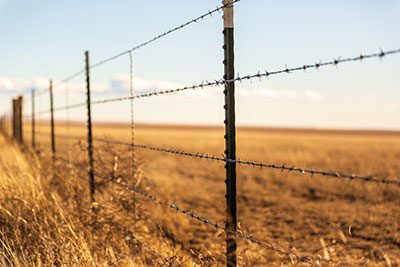
If you have ever driven through rural areas, you have seen a barbed wire fence. Barbed wire fences are also called razor wire fences.
Barbed wire fencing has twisted wires made of steel, arranged horizontally and fastened between wood posts. The barbed wire fencing also uses horizontal wires strung on T-posts or similar fence posts to ensure the barbs.
Sharp barbs are evenly arranged along each line of the razor wire lines. Barbed wire fences are typically used on large properties with livestock, especially cows, to prevent predators from entering. In addition, you can combine the barbed wire fence, such as wood rails and similar fencing types to fortify the fencing construction better.
Barbed wire fencing can be installed to make enclosures for cattle or pigs. The razor wire can keep pests out of your garden, but it may not be the safest option if you have young children or pets who can be injured by the barbs.
The cost of a barbed wire fence varies between approximately $0.03 to $0.08 per linear foot or about $60 to $110 per roll, with each roll being 1,320 feet long.
Can you make electric fences out of barbed wire fencing?
You should never use your bared wire as an electric fence. If some adult, child, or animal catches on the barbed wire and receives the shock, it will result in fatal injuries, as they cannot release themselves from the barbed wire.
So, as long the safety is jeopardized, you must not install electric wires onto your barbed wire lines.
Welded wire fencing
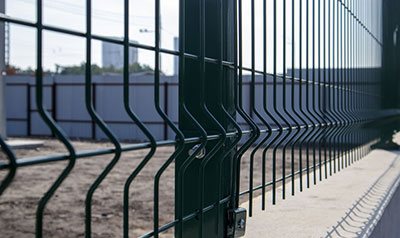
A welded wire fence is made up of wires that run vertically and horizontally due to a technique called spot welding. Welders melt the wires together at their crossing points. As a result, a sturdy and smooth welded wire fence is created.
Welded wire fencing is suitable for most residential and commercial applications. Welded wire fences also provide a sleek industrial feel to any backyard or area.
Industrial-grade materials of welded wire fencing can be used for extremely long-lasting fencing due to the welding of the wires together. You might find welded wire fences around gardens, pools, nature reserves, parks, and dog runs or kennels. These fences have a more stable structure than woven wire fencing with a loose structure.
For material and labor, the cost of adding a welded wire fence to your property is roughly $4 to $10 per linear foot.
Woven wire fence
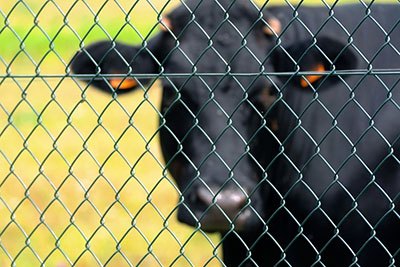
Woven wire fencing is similar to welded wire fences as they both have vertical and horizontal wires intersecting to create the fence. But, instead of welding them together, the manufacturer wraps the wires around each other.
If you have ever seen a chain-link fence, then you have seen one of the most common forms of woven wire fencing. This fence uses a fence stretcher to extend its shape and size and keep the mesh optimal for robust uses.
Woven wire fences work best for keeping pets, dog runs, or livestock contained. The different gauges (thicknesses) available are based on the fence’s purpose. The lower the gauge number, the thicker the wire fence, and oy u can use the fence stretcher to adjust it to your needs. But, it’s not as stable as the welded wire fencing.
Thicker wire gauge is suitable for heavy-duty usage like containing larger animals like horses or cattle. Smaller gauges of woven fencing (higher numbers) are best suited for gardens and small animals.
The cost of chain-link types of woven wire fences is around $10 to $20 per linear foot on average. In contrast, other woven wire fences cost about $0.10 to $0.14 per braid, with multiple braids being required for each type of wire fence.
Electric fencing
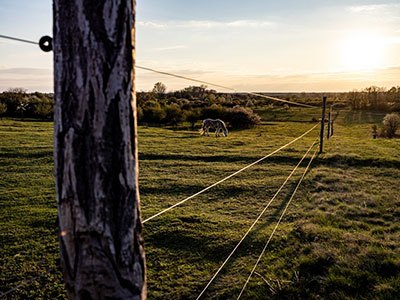
Electrified fencing is typically set between 2,000 and 10,000 volts, generating a shock that is not enough to harm humans or animals. The electrified fences are often found on farms, where they help contain livestock and deter predators.
The shock of the fence line cannot harm the animals or intruders. The electrified fencing only serves as boundary lines for protecting gardens, yards, and other domestic animals. You can attach the fence material to different wooden posts, steel, metal, and similar posts, and use this type of electric wire fencing for perimeter fencing as well. Find more information HERE.
However, it is important to keep in mind that high-security areas such as military sites, prisons, or commercial lots may use electrified fences with higher voltages that can produce powerful shocks.
To install an electrified fence, the cost is approximately $2.40 to $3.90 per linear foot. Although many individuals can install their electrified fences, it is advisable to hire a professional fence company for electric wire fences. Improper installation could result in injuries to humans or animals, even death.
Even after hiring a professional, it is essential to avoid touching the electrified fencing wire/conductive wire or allowing others to do so.
Vinyl-coated wire fencing
Vinyl-coated wire fences include a substantial layer of vinyl coating over welded or woven wires. The coated wire fencing materials, usually available in green or black, aims to offer a gentler surface just in case animals or humans come into contact with the fence.
As a result, you might find vinyl-coated wire fences around playgrounds or swimming pools, considering them a safer type of wire fencing for kids who unintentionally touch them.
For materials and labor, VC wire fences have a total cost of around $12 to $39 per linear foot, making them neither the most nor least expensive wire strands.
Metal types of wire fencing
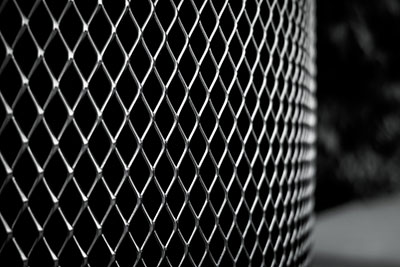
Metal fences are popular types of wire fences for many homeowners and businesses due to their durability, aesthetic appeal, and security.
Metal types of wire fences come in a variety of styles, from ornamental wrought iron to chain-link fences, and can be used for a variety of applications such as pool enclosures, a perimeter fence, pet containment, and more.
Metal fences are typically made from steel wire fencing or aluminum wire fencing with a powder coat for extra protection against the elements. Steel wire is the most durable option but is also heavier than aluminum. Aluminum is lightweight and corrosion-resistant but may not be as strong as steel.
When it comes to types of metal fences, there are several options available. Wrought iron is an ornamental type that is often used for decorative purposes such as gates or accents on other types of fencing.
Chain-link wire fence coating is one of the most common types used for security purposes due to its strength and affordability. A wire fence can be used for small animal containment or as a decorative accent around gardens or pools.
The cost of metal fence installation varies depending on the type of fence chosen and the size of the area being fenced in. Generally speaking, metal fences cost between $20-$30 per linear foot installed with wrought iron being at the higher end of that range due to its ornamental nature.
Aluminum wire fencing
Aluminum is a preferred option when building wire fences due to its lightweight characteristics. Additionally, it is a common material utilized to build thin, electrified wire fences because of its excellent conductivity.
Aluminum fences have the advantage of weathering well against rain and moisture. Thus, these types of wire fencing reduce concerns over rust and corrosion that often afflict other wire fence materials.
Nonetheless, the disadvantage of the aluminum type of wire fencing is its relatively lower durability compared to steel wire fences. However, the price for installing an aluminum wire fence is cheaper, ranging from $7 to $40 per linear foot.
Steel wire fences

Thin steel is another material commonly used by manufacturers for electric wire fences due to its excellent electricity-conducting properties. Unlike aluminum, this type of wire fence is more durable, and stainless steel can endure corrosion and strong coastal winds.
Steel fence installation incurs higher upfront costs than other wire materials, which are approximately $37 to $60 per foot for materials and labor. However, the steel wire is famous for its robustness and long-lasting quality making it an alluring option for many individuals when starting a new fencing project.
Chicken wire fencing
Chicken wire is another name for wire netting or poultry netting and is a widely used type of wire fence that is ideal for confining small animals or safeguarding gardens from pests, particularly rodents.
Galvanized wire steel is the most common material used to make chicken wire netting, and manufacturers twist and seal the wires together to form hexagonal shapes.
Despite its usefulness in protecting chickens and crops from small mammals and rodents, chicken wire alone is insufficient to keep out larger predators such as coyotes or foxes. If you live in an area where more massive animals are a concern, you should consider installing a more robust wire fence, such as a traditional woven wire or welded wire fencing.
Installing chicken wire fences is budget-friendly, with a cost range of approximately $2 to $4.50 per linear foot, making it a practical option for enclosing small animals.
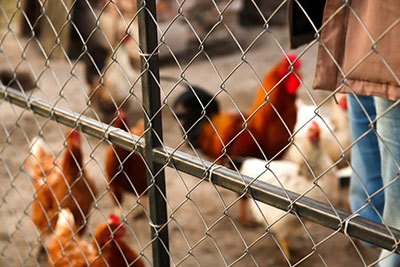
Straining line wire fences
Straining line wire fences share a similar look with barbed wire fences, having horizontal wires stretched between fence posts, except for the absence of sharp barbed points.
As a standalone fence, straining line wire fencing provides little security. Instead, it serves to run tightly along the tops of fence posts and enhances the fence’s stability and durability to cope with any animal’s sudden vigorous movements.
For straining line wire farm fencing, the cost ranges from $2 to $20 per linear foot. Alternatively, you may pay per the number of wires required for the fence.
E-coating fencing system
E-coating is a process of dipping wire into the paint, also called electroplating. An electric charge is then passed through the paint, resulting in a chemical reaction that strengthens the e-coating. Before applying the e-coating, the wire is often galvanized to prevent corrosion.
Different types of wire fences use this coating method to enhance durability by preventing rust, which is the primary cause of fence destruction. These wire fences require minimal maintenance and offer long-lasting protection against corrosion.
Poly wire fences
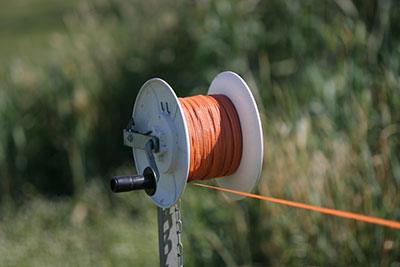
Poly wire fencing is used to ensure better visibility when constructing an electrified fence. The strands are exceptionally bright in color, making them easy to spot. They are twisted alongside conductive wires and then electrified at a later stage.
Poly wire, like stainless steel, is resistant to corrosion, making it an excellent choice for containing livestock. Moreover, animals that may get entangled in it are not severely injured.
Poly wire fencing offers the added benefit of being safe for animals that come in contact with it. Poly wire fences can range in price from under $25 to over $100, depending on the type and length of the fencing.
Galvanized before fences – GBW wire systems
Galvanized fences are an increasingly popular choice for homeowners due to their durability and affordability. Galvanization is a process of coating steel or iron with a protective layer of zinc, which helps to prevent rust and corrosion. This makes galvanized fences ideal for outdoor applications such as pool enclosures, gardens, and patios.
The benefits of galvanized fences include the fact that they are low maintenance and require no painting or staining. The galvanized coating is also highly durable and can withstand extreme weather conditions such as high winds, rain, snow, and heat. In addition, galvanized fences are relatively inexpensive compared to other types of fencing materials like wood or vinyl.
Galvanized types of wire fencing can be used in a variety of applications including residential homes, commercial businesses, industrial sites, agricultural farms, and public parks. They can also be used to create decorative accents around pools or gardens.
The price of galvanized fences will vary depending on the size and type of fence you choose. The cost of galvanized-before fencing can range from $10-$50 per linear foot.
Galvanized after fences – GAW wire systems
Galvanized-after fences are a type of welded wire mesh and fence that is strong and durable. They are made by dipping previously welded mesh into a bath of molten zinc, which provides an extra layer of protection against corrosion and rust. This makes them ideal for outdoor applications such as bird pens, rabbit cages, garden enclosures, and more.
The galvanized-after process also ensures that the fence is long-lasting and predator resistant. The zinc coating helps to protect against wear and tear from weather exposure, making it a great choice for areas with extreme temperatures or climates. Additionally, the galvanized-after process adds strength to the fence, making it more secure than other types of fencing.
The price per linear foot for galvanized-after fences varies depending on the size and type of fence you choose. Generally speaking, these fences can range anywhere from $10-$30 per linear foot depending on the size and material used.
Powder-coated wire fences
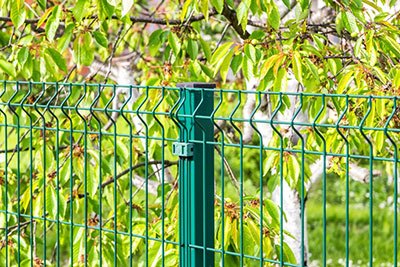
Powder-coat wire fencing is a type of metal fence that is made from galvanized steel or aluminum wires that have been coated with a protective layer of powder coating. This coating helps to protect the metal from corrosion and rust, making it an ideal choice for outdoor applications. The powder-coated finish also gives the fence a more attractive appearance than other types of metal fencing.
The main benefit of powder-coated wire fencing is its durability and long lifespan. It can withstand extreme weather conditions and will not corrode or rust over time. Additionally, the powder coating provides an extra layer of protection against UV rays, which can cause fading and discoloration in other types of metal fences.
Powder-coated wire fencing can be used for a variety of applications, including residential and commercial properties, farms, ranches, parks, schools, playgrounds, airports, and more. It is also popular for use as pet enclosures or animal pens due to its strength and durability.
The cost of powder-coated wire fencing varies depending on the size and type of fence you choose. Generally speaking, it costs around $15-$20 per linear foot installed.
FAQs
What are the three types of wire fences?
The main three types of wire fencing include:
– prefabricated wire fencing rolls
– plain wire
– barbed wire fence
What are the different types of woven wire?
The three main types of the woven wire fence include:
– Plain woven wire fencing
– Lock crimp woven wire fence
– Intercrimp woven wire fence.
What is the most durable wire fencing?
The most durable wire fencing is the vinyl-coated wire fence, thanks to its protective coating and composite fence material.
How many types of fencing are there?
Our list includes fifteen different types of wire fences to ensure everyone’s needs.
Which type of fencing wire is the cheapest?
The chain-link fence is the most cost-effective wire fencing model for your needs. The chain link fence is also the easier wire fencing unit to install.
Is wire fencing cheaper than wood?
Among all types of wire fencing, chain-link wire fencing is less expensive than wood fences.
Summary
There are multiple types of wire fencing models to choose from and pick the best solution for your needs.
Ensure you know their benefits, drawbacks, and prices in advance to avoid further complications, and make sure your farm property is safe from different intruders.
